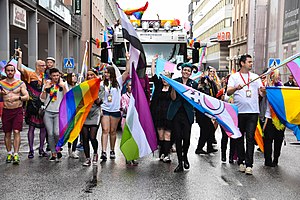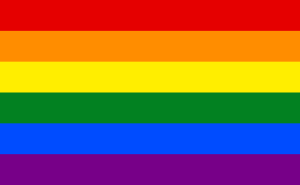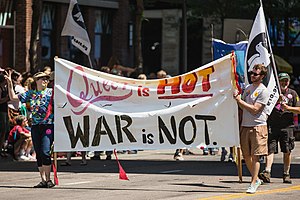LGBT
| |

LGBT is short for "Lesbian, Gay, Bisexual, and Transgender." It is the most well-known collective term for the community of gender, sex and sexuality minorities. Many towns and universities have LGBT groups for local socialising, networking, and activism.
Variant and alternative acronyms
The LGBT acronym is sometimes written as LGB, intentionally not including transgender people as part of this group. This can be accurate for resources and groups are only about sexual orientation, not gender identity. Depending on location, LGBT is also sometimes written in a different order: GLBT.
Since the use of the term LGBT became widespread, other minorities have been accepted into the community and added to the end of LGBT acronym in various combinations. These include: Intersex, Pansexual, Asexual, Queer, Questioning, Two-spirit, and others. This results in a variety of acronyms, such as LGBTQ, LGBTQ2, LGBTIQAP, LGBTQQAP, etc. Since the string of letters can get very long, some writers just imply them by writing a plus sign on the end, such as LGBT+, or LGBTQQAP+. The A, when it is added, can refer to asexual and aromantic. However, there has been some debate that the A stands for allies. This comes from the belief that the term "ally" used to describe a closeted LGBT+ community member who wanted to be a part of the community while also protecting themselves from their unsafe or unsupportive environment.
Because the ever longer acronym can become cumbersome to say, some propose rearranging the letters into different acronyms. Others propose an entirely different acronym that summarizes the commonalities of LGBT+ identities, rather than listing them, such as:
- QUILTBAG (queer/questioning, undecided, intersex, lesbian, transgender, bisexual, asexual, gay) was among the first proposed alternative acronyms. Though it is longer, having the acronym be a pronounceable word made it easy to talk about. However this also leads to confusion, as it is not a distinct word.
- SAGA (Sexual and Gender Acceptance) is among the acronyms that seek to describe the common threads amongst the community, rather than list out all the possible identities. However, like QUILTBAG, it is a word that has a different meaning, which causes confusion. It also can describe an organization, Sexuality and Gender Alliance.
- GSM (gender and sexuality minorities), or GSRM (gender, sex, and romantic minorities). Criticisms of this term: This excludes some people it shouldn't, such as intersex people, whose sex is neither a gender nor a sexuality. This term has been considered harmful because it could include some kinds of people it shouldn't: people who aren't LGBT+, such as cisgender heterosexual people who consider themselves "sexuality minorities" because they have unusual sexual fetishes, or even harmful paraphilias such as pedophilia.[1]
- MOGAI (marginalized orientations, gender alignments, and intersex), or MOGII (marginalized orientations, gender identities, and intersex). These terms include intersex people, while excluding people who aren't LGBT+. MOGII is perhaps easier to say, while MOGAI is more accurate (cishet dyadic women have a marginalized gender identity, but their gender aligns with their assigned gender at birth so they are not a marginalized gender alignment).[1][2] Though this term seeks to be the most inclusive, it has been criticized by some for the same reasons "GSM" has gained criticism. In some contexts, MOGAI is used to refer only to "newer" or more "niche" identities (such as xenogenders for example), so you will sometimes see people who are "pro-LGBT and anti-MOGAI" although the latter term technically includes the former.
Queer
Queer is a word with a complex history. Some people choose not to use an acronym, and instead use the word "queer" as a collective term for all these LGBT identities. It is used as a concise way of referring to all parts of the LGBT community. It's also used for all the more difficult-to-define identities that are not heterosexual and/or not cisgender.
Beginning in around the 1980s the word "queer" began to become a political reclamation. Flyers like one circulated in the 1990 New York Pride Parade proclaimed queer as a word indicative of a rejection of heteronormative standards [3] . For many people even today, "queer" represents a rejection of assimilation and respectability politics.
However, "queer" has, and remains in some places, a slur used towards LGBT people[4][5]. The degree to which queer is an offensive word varies by region and by generation. In the early 1990s, the academic discipline of queer theory emerged. This comes from the use of "queer" as a political statement and a gender stance, which places the queerness as being against assimilation. The field of queer theory not only looks into LGBT history, but the ramifications of queer theory itself[6].
However, in other settings, whether rural or urban, queer is a strong slur against LGBT people. In hate crimes, the word is used along with or instead of strong slurs. As with other hate speech, it is very common among LGBT+ people for the word to be a trigger for post-traumatic flashbacks of memories of violence, harassment, and abuse. As explained by non-gendered activist Christie Elan-Cane, LGBT people who are used to hearing it used as a slur don't want academics and psychologists apply it to them, and they don't like the word genderqueer.[7][8]
See also
References
- ↑ 1.0 1.1 Bird (2014). "About MOGAI and MOGII". Archived from the original on 19 November 2014.
- ↑ "why I've started using MOGAI". 19 September 2014. Archived from the original on 26 December 2019.
- ↑ http://www.qrd.org/qrd/misc/text/queers.read.this
- ↑ Cassell's Dictionary of Slang, 2nd ed (2005), p. 1161.
- ↑ The Routledge Dictionary of Modern American Slang and Unconventional English (2008), p. 792-793.
- ↑ https://books.google.co.uk/books?id=PNYlUuvPOQ8C&pg=PA1&source=gbs_toc_r&cad=3#v=onepage&q&f=false
- ↑ Christie Elan-Cane. November 5, 2011. http://elancane.livejournal.com/9367.html
- ↑ Mac. November 7, 2011. http://nonbinary.tumblr.com/post/12475693948/when-umbrella-terms-cause-offence-christie


